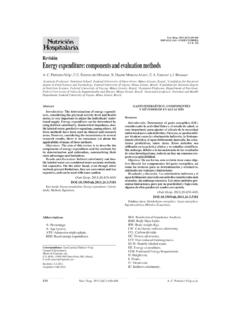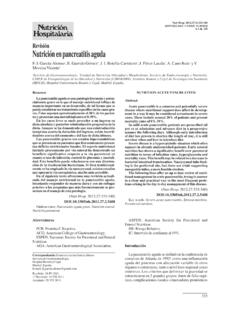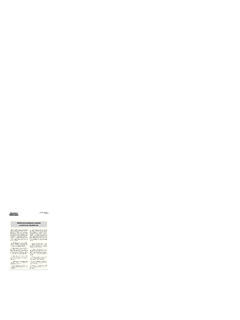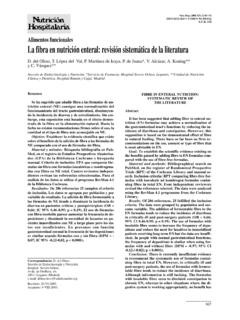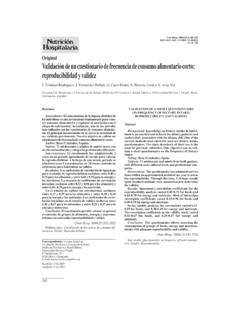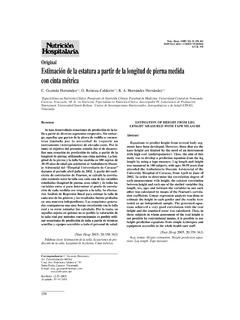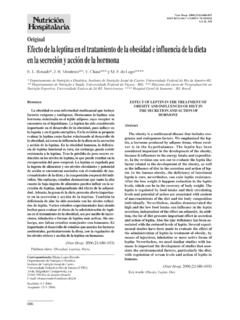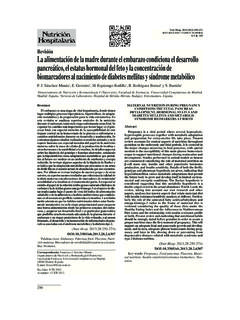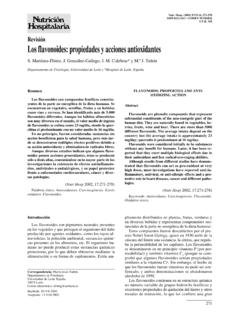Transcription of Interactions between antihypertensive drugs and food
1 1866 Nutr Hosp. 2012;27(5):1866-1875 ISSN 0212-1611 CODEN 318 Revisi nInteractions between antihypertensive drugs and foodB. J uregui-Garrido1and I. J uregui-Lobera21 Department of Cardiology. University Hospital Virgen del Roc o. Seville. Spain. 2 Bromatology and Nutrition. Pablo deOlavide University. Seville. ENTRE F RMACOSANTIHIPERTENSIVOS Y ALIMENTOSR esumenObjetivo:la interacci n de medicamentos se define comocualquier alteraci n, farmacocin tica y/o farmacodin -mica, producida por diferentes sustancias, otros tratamien-tos, factores diet ticos y h bitos como beber y fumar. Estasinteracciones pueden afectar a los f rmacos antihipertensi-vos, alterando su eficacia terap utica y causando efectost xicos. El objetivo de este estudio fue realizar una revisi nde los datos disponibles acerca de las interacciones entre losf rmacos antihipertensivos y los todos:El objetivo de esta revisi n fue proporcionaruna puesta al d a sobre los principales resultados con res-pecto a las interacciones entre alimentos y f rmacos antihi-pertensivos mediante una b squeda realizada en PubMed,que dio lugar inicialmente a un total de 236 art :Tras la exclusi n de diferentes art culosque no estaban centrados en el objetivo espec fico, losresultados principales se refieren a las interacciones entrelos f rmacos antiarr tmicos y alimentos en general yentre dichos f rmacos y el zumo de pomelo.
2 Discusi n:Los alimentos pueden afectar a la biodispo-nibilidad de los f rmacos antihipertensivos y ello debe serconsiderado cuidadosamente. Advertir a los pacientesque supriman el zumo de pomelo en su dieta cuando est nen tratamiento con estos f rmacos parece la mejor reco-mendaci n. Dadas estas interacciones y sus potencialesefectos adversos, la anamnesis debe incluir informaci ndetallada sobre los h bitos alimentarios de los pacientes.(Nutr Hosp. 2012;27:1866-1875) clave: F rmacos antihipertensivos. Interaccionesentre alimentos y medicamentos. Zumo de pomelo. :A drug interaction is defined as any alter-ation, pharmacokinetics and/or pharmacodynamics,produced by different substances, other drug treatments,dietary factors and habits such as drinking and Interactions can affect the antihypertensive drugs ,altering their therapeutic efficacy and causing toxiceffects. The aim of this study was to conduct a review ofavailable data about Interactions between antihyperten-sive agents and :The purpose of this review was to report anupdate of main findings with respect to the interactionsbetween food and antihypertensive drugs by way of asearch conducted in PubMed, which yielded a total of 236articles :After excluding different articles, which werenot focusing on the specific objective, the main resultsrefer to Interactions between antihypertensive drugs andfood (in general) as well as between antihypertensiveagents and grapefruit juice.
3 Discussion:Food may affect the bioavailability of anti-hypertensive drugs and this should be carefully consid-ered. Advising patients to remove the grapefruit juicefrom their diet when treatment with these drugs seems tobe the best recommendation. Given these interactionsand the associated potential adverse effects the anamnesismust include detailed information about the specificeating habits of the patients. (Nutr Hosp. 2012;27:1866-1875) words: antihypertensive drugs . Food- drugs interac-tions. Grapefruit juice. : Angiotensin-converting : Angiotensin II receptor receptor: Angiotensin 1 : Area under the curve (Area under the plasmaconcentration time curve).BA: : Blood : Maximum plasma : cyclic guanosine : Cytochrome P450 gene : Dietary Approach to Stop : Diastolic blood : : Inositol : I. J and de Olavide del Monte, Seville. : / : Interactions :01. Interacci n 29/11/12 14:38 P gina 1866 NaCl: Sodium chloride, common : Organic anion : Organic cation : : Systolic blood : drug elimination : Time after administration of a drug when themaximum plasma concentration is (HT), which is defined as a chronicelevation of systolic and/or diastolic blood pressure(BP), is in all probability the most common chronicdisease today.
4 The main clinical significance of HT,which is not a disease in the usual sense of the word,lies on the future risk of vascular disease. Apart fromvarious causes of HT, the most frequent case is theessential HT (up to 95%).1,2In the regulation of BP, there are different involvingfactors (sympathetic nervous system, kidney, hormonalsystems), one of them being the composition of the , sodium, potassium, magnesium, lipids and totalenergy intake influence the control of the largestinternational study on the relationship between sodiumand BP (INTERSALT),4the analysis of more than10,000 participants showed that a variation of 100 mmolsodium intake modified the systolic BP (SBP) , being lower the effect on diastolic BP (DBP). Asfor diet, one of the most relevant studies (DASH: DietaryApproaches to Stop Hypertension)5showed that BPlevels decreased with a diet low in saturated fat, choles-terol and total fat and high in fruits, vegetables andskimmed or semi-skimmed milk, that is a diet rich inmagnesium, calcium, potassium, protein and fibre.
5 In alater study (DASH-sodium),6it was observed that withany level of sodium, the greatest reduction in BP wasachieved with the DASH diet and even better with asodium intake of only 1,500 mg of sodium per the treatment of HT, it is correct when itscontinued efficacy is proven and it has minimal sideeffects. The goal is to achieve and maintain a SBPbelow 140 mmHg and a DBP below 90 general measures of treatment (stress manage-ment, moderate salt restriction, regular exercise andmoderate reduction of other risk factors) 8there is a fullarsenal of antihypertensive drugs : diuretics, alpha andbeta-blockers, calcium channel blockers, angiotensin-converting enzyme (ACE) inhibitors, angiotensin IIreceptor blockers (ARBs) and others such as sodiumnitroprusside, monoxidine, hydralazine and regard to the bioavailability (BA) of antihyper-tensive drugs , it is noted the importance of thecytochrome P450, a family of enzymes (encoded by thegene CYP) located in the liver and gastrointestinal tract,which represents the major source of metabolic activityfor the phase I reactions.
6 Regarding the use of other drugsand food intake, it is remarkable the presence of inducersand inhibitors of the CYP system, so the association ofantihypertensive drugs with other drugs and/or foodwhich use the CYP for their metabolism may be with CYP, it should be noted, due to its meta-bolic importance, the P-glycoprotein (P-gp), a family ofmembrane transporters located in the brush border of theenterocytes membranes. In addition to mobilizingendogenous substances, the P-gp mobilizes certain drugsincluding some antihypertensive Interactions are defined as any alteration, phar-macokinetics and/or pharmacodynamics, produced bydifferent substances, other drug treatments, dietaryfactors and habits such as drinking and Interactions may affect the antihypertensivedrugs, modifying their therapeutic efficacy and theadverse aim of this study was to conduct a review ofavailable data about Interactions between antihyper-tensive drugs and review was conducted through a PubMed initial search term was Interactions between antihy-pertensive drugs and food, which resulted in a total of337 articles.
7 Later, other specific searches wereperformed, by entering Interactions between loopdiuretics and food , Interactions between calciumchannel blockers and food , Interactions between ACEinhibitors and food , Interactions between ARBs andfood , Interactions between hydralazine and food and Interactions between grapefruit juice and antihyperten-sive agents . Having excluded the repeated articles, a totalof 236 articles were considered. Then those that did notmake specific reference to the object of the review wererejected. Articles without an abstract were also respect to case reports and letters, because of thescarcity of articles focusing specifically on a subject,some of them were considered. Apart from the articlesincluded after the search, some other articles and/or chap-ters were considered due to its between food and diuretics The simultaneous intake of food and some loopdiuretics such as furosemide and bumetanide causes adecrease of the BA of these drugs , which in the case offurosemide seems to be very high (approximately30%).
8 13In a review, Bard et al. corroborated the exis-tence of a decrease in the BA of loop diuretics whenadministered orally with food, although, only onestudy found a decrease in urinary excretion of thesedrugs after taken with food (such excretion is related tothe threshold of the diuretic effectiveness) 14. In rats withprotein-calorie malnutrition, the BA of furosemideAntihypertensive drugs -food interactions1867 Nutr Hosp. 2012;27(6):1866-187511. Interactions :01. Interacci n 29/11/12 14:38 P gina 1867significantly increased after oral administration, a factattributable to a decrease in the metabolism of gastroin-testinal and hepatic first respect to spirono-lactone and canrenone, its major active metabolite,food intake with simultaneous drug intake increasesthe BA of both drugs by increasing its absorption andpossibly reducing the first pass ,17 Thisfood intake also increases the BA of hydrochlorothia respect to indapamide, a study has revealedthat its administration in sustained release form is unaf-fected when taken with between food and alpha- and beta-blockersBlockers of 1-adrenergic receptors causes acompetitive and reversible blockage of those receptors,thus lessening or removing the actions of cate-cholamines mediated by way of the stimulation ofthose receptors.
9 In regard to -adrenergic blockers,these agents block competitively and reversibly theactions of catecholamines mediated by way of the stim-ulation of -adrenergic receptors. Furthermore, someof these agents have vasodilator properties, which areassociated with an increase in nitric oxide release orwith the blocking of the -adrenergic respect to doxazosin, the BA of a single dose of 8mg by means of a controlled release gastrointestinal formunder fasting conditions and after ingestion, and a singlestandard dose of 2 mg under fasting conditions have beenstudied comparatively. Under fasting conditions, Cmaxwas similar for both presentations, with a BA of 75% inthe case of the sustained release form with respect to thestandard one. In the case of the sustained release form, anadministration with fat-rich food leads to a Cmaxand AUC31% and 18% higher indoramin, there are not any publishedstudies with respect to its use as antihypertensive andpossible drug -nutrients Interactions .
10 The same appliesto prazosin from a clinical point of urapidil, a pioneer study showed that foodintake did not influence the BA of the drug when adminis-tered in tablet form. However, after administration by asustained release formulation, Cmaxand tmaxincreased,whereas t1/2decreased with food intake. Despite thesedifferences, the AUC was not influenced by concomitantfood intake in the case of sustained release form. In fasting,the AUC after administration of the sustained release formwas 28% lower than after administration of the standardform, while food intake, with the sustained release capsule,eliminated such difference. Since the decreases of BP inhypertensive patients treated with urapidil are morepronounced in the inclined portion of the curve of serumconcentration of the drug , maximizing that part of thecurve, as is the case of administration of the sustainedrelease capsule with breakfast, could be the case of prazosin, an animal experimental workhas shown that its administration at the paraventricularnucleus of the hypothalamus is able to reduce the SBPonly in undernourished , no studiesconcerning potential Interactions between the drug andfood in humans are developed.
